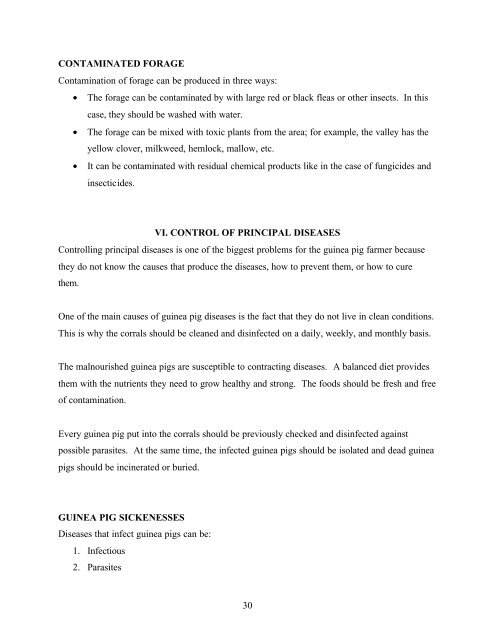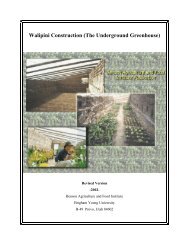GUINEA PIG MANAGEMENT MANUAL - Benson Institute
GUINEA PIG MANAGEMENT MANUAL - Benson Institute
GUINEA PIG MANAGEMENT MANUAL - Benson Institute
You also want an ePaper? Increase the reach of your titles
YUMPU automatically turns print PDFs into web optimized ePapers that Google loves.
CONTAMINATED FORAGE<br />
Contamination of forage can be produced in three ways:<br />
• The forage can be contaminated by with large red or black fleas or other insects. In this<br />
case, they should be washed with water.<br />
• The forage can be mixed with toxic plants from the area; for example, the valley has the<br />
yellow clover, milkweed, hemlock, mallow, etc.<br />
• It can be contaminated with residual chemical products like in the case of fungicides and<br />
insecticides.<br />
VI. CONTROL OF PRINCIPAL DISEASES<br />
Controlling principal diseases is one of the biggest problems for the guinea pig farmer because<br />
they do not know the causes that produce the diseases, how to prevent them, or how to cure<br />
them.<br />
One of the main causes of guinea pig diseases is the fact that they do not live in clean conditions.<br />
This is why the corrals should be cleaned and disinfected on a daily, weekly, and monthly basis.<br />
The malnourished guinea pigs are susceptible to contracting diseases. A balanced diet provides<br />
them with the nutrients they need to grow healthy and strong. The foods should be fresh and free<br />
of contamination.<br />
Every guinea pig put into the corrals should be previously checked and disinfected against<br />
possible parasites. At the same time, the infected guinea pigs should be isolated and dead guinea<br />
pigs should be incinerated or buried.<br />
<strong>GUINEA</strong> <strong>PIG</strong> SICKENESSES<br />
Diseases that infect guinea pigs can be:<br />
1. Infectious<br />
2. Parasites<br />
30



